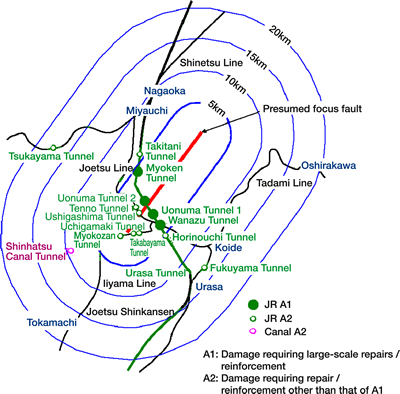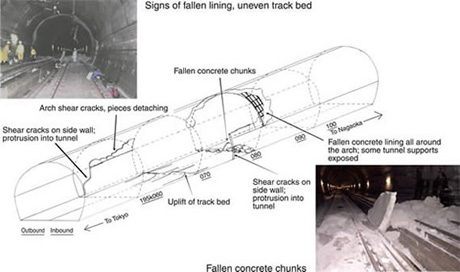Press Releases(Archive)
Measures for Locations Similar to Those Damaged by Niigata Chuetsu Earthquake
Supplement 2
The October 2004 Niigata Chuetsu Earthquake caused damage in the Uonuma Tunnel, with parts of the tunnel's lining falling, and it also damaged the No. 3 Wanazu Viaduct. In response, JR East is working to reinforce similar structures against earthquakes. Places being reinforced include Shinkansen tunnels approaching or crossing active faults and Shinkansen viaducts with columns that are constricted near the center.
1.Reinforcing tunnels approaching or crossing active faults
(1) Aseismatic reinforcement of Shinkansen tunnels approaching active faults
After the October 2004 Niigata Chuetsu Earthquake, an internal group was formed called the Committee for Investigating the Cause of Railway Tunnel Damage in the Earthquake in Chuetsu, Niigata Prefecture, chaired by Professor Toshihiro Asakura of the Kyoto University Graduate School. The group has been investigating the causes of tunnel damage and weighing countermeasures, and the results of these efforts have been summarized here. Shinkansen tunnel earthquake reinforcing countermeasures are being examined, based on the suggestions of the study group.
A. Presumed causes of tunnel damage
The tunnels that sustained heavy damage from the earthquake were all located within about 5 km from the presumed focus fault, but there were cases where, in the same location, some places were heavily damaged and others were not damaged at all. A variety of studies, some of them involving boring out samples, were performed on the damaged and undamaged places in the tunnels. From the results, it is conjectured that a combination of three sets of conditions (distance, geological and structural) led to large-scale damage, including major deforming of the ground and tunnel lining.
| Distance conditions: | Large-scale damage was concentrated in locations within about 5 km of the presumed focus fault. |
| Geological conditions: | "Sites of poor ground," such as areas with low ground strength, around tunnels. |
| Structural conditions: | Construction in which the lining is easily deformed, such as places with voids behind the lining |
- Niigata Chuetsu Earthquake damage
Distribution of tunnel damage resulting from Niigata Chuetsu Earthquake
(concentrated within about 5km from the presumed epicenter fault)
- Uonuma Tunnel deformation diagram
B. Shinkansen tunnel earthquake countermeasures

The following earthquake countermeasures are being examined with the objective of preventing large-scale damage such as the collapse of the lining in tunnels, in the event of an earthquake similar in scale to the Niigata Chuetsu Earthquake. - Determining tunnels to undergo earthquake countermeasures examination
After selecting the Shinkansen tunnels within 5 km of active faults based on existing reliability and past levels of activity, we will narrow the list down to sections upon which countermeasures will be taken based on geological and structural conditions and other factors. - Selection of earthquake countermeasures
Three types of earthquake countermeasures were considered: filling in voids according to the state of the back face (back-fill grouting), lock-bolting, and inner surface reinforcement. JR East is now making the surveys necessary to decide on countermeasures.
(2) Reinforcement of Shinkansen tunnels crossing active faults
The Shinkansen Derailing Countermeasures Council of the Ministry of Land, Infrastructure and Transport has given an intermediate report of its findings on Shinkansen tunnels crossing active faults. Their study of the back face of the tunnel lining has resulted in two tunnels (the Zao Tunnel on the Tohoku Shinkansen line and the Shiozawa Tunnel on the Joetsu Shinkansen line) being designated as needing void filling in the back face (back-fill grouting), work which is to be performed in the current fiscal year.
- Stance on aseismic measures for Shinkansen tunnels
[Objective]
To prevent damage such as falling of tunnel lining in the event of an earthquake of similar scale as the Niigata Chuetsu Earthquake
| Determination of tunnels to be reinforced |
|
|||||||||
| Measures | Procedures | Back-fill grouting | Lock-bolting | Inner surface reinforcement | ||||||
| Diagram |  |
 |
 |
|||||||
| Place | Places where there are voids on the back face and places with shallow soil cover | Places without inverts | Places where arch lining requires reinforcement | |||||||
| Effect | Dissipates and equalizes ground pressure on tunnel lining, prevents destruction of lining resulting from local stress concentration | The lock-bolt that is driven in serves in place of an invert to reinforce the tunnel structure | The lining is reinforced from the inside, giving it more strength | |||||||
2.Countermeasures for sites resembling the No. 3 Wanazu Viaduct
The No. 3 Wanazu Viaduct, between Urasa and Nagaoka on the Joetsu Shinkansen line, was not at first a candidate for earthquake reinforcement, because the original earthquake diagnosis indicated the damage was not of the type preceding shear failure. However, because the viaduct sustained damage as a result of the foundational concrete of the snow melting base constricting the viaduct columns, it was decided to establish a reinforcement plan for similar viaducts and complete this work by the end of FY2006, as was indicated in the intermediate report of the findings of the Shinkansen Derailing Countermeasures Council.
![[Example: Nakagawa Viaduct, between Tsubame-Sanjo and Niigata on the Joetsu Shinkansen line]](img/img02_6.gif)
[Example: Nakagawa Viaduct, between Tsubame-Sanjo and Niigata on the Joetsu Shinkansen line]
No. of columns reinforced
| Line | No. of columns |
| Tohoku Shinkansen | 22 |
| Joetsu Shinkansen | 69 |
| Total | 91 |